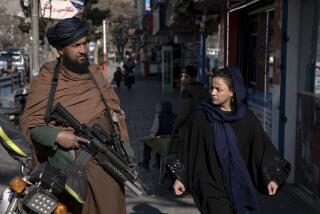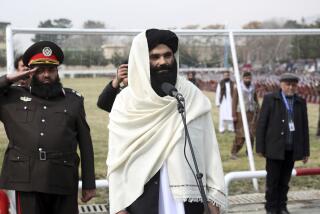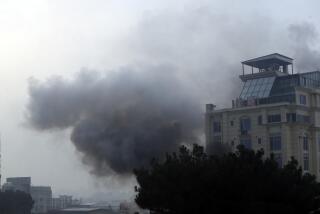Afghan forces’ strengths, failures on display in Kabul siege
KABUL, Afghanistan — The Afghan police and army have won praise for fighting off one of the war’s most ambitious insurgent strikes, but the marathon siege of key diplomatic, government and military installations in Kabul also highlighted worrisome weaknesses, including glaring intelligence failures.
With evidence pointing to a virulent Taliban offshoot known as the Haqqani network as the perpetrators of the tightly coordinated assaults, the prospect of protecting Kabul appears even more difficult. The group has ready access to infiltration routes from Pakistan and is strong in provinces surrounding the capital, three of which were also the scene of the apparently linked attacks Sunday.
The outcome of the 18-hour bout of fighting that ended early Monday — insurgent deaths outnumbering those of security forces more than 3 to 1, and the attackers failing to penetrate sensitive targets such as the Afghan parliament — is being cited by Western and Afghan officials as proof that Afghan forces will soon be ready to take over the task of confronting the Taliban and other militant groups without coalition assistance.
That transition is key to the U.S. effort to extricate itself and its allies from the decade-long conflict. In the coming year, the combat role is to revert almost exclusively to the Afghans, with most Western troops departing in 2014.
But the attacks, which paralyzed large swaths of Kabul, also point to a central conundrum. Western officials portray this brand of urban warfare as a sign of insurgents’ frustration with their inability to directly take on NATO forces on the battlefield. But the Taliban and other militant groups instead see success; the mere ability to carry out attacks of this size and scope, they believe, undermines the faith of Afghan citizens that their government can protect them.
On Monday, people living and working close to the attack venues were left to literally pick up the pieces, sweeping up broken glass and debris as they spoke of the perils of daily life.
“We are not safe — we are in danger 24 hours a day,” said Ahmad Farhad, a 22-year-old shopkeeper whose tiny establishment is close to a hotel that was hit by rocket fire.
“We’re not satisfied with the government,” said Mohammad Jahfar, a 19-year-old who was also trapped by the fighting. “We fear we’ll be killed today, or tomorrow.”
As in several previous skirmishes, including a 20-hour siege of the U.S. Embassy compound in September and an all-night assault in June on a landmark Kabul hotel, it took many hours to bring the situation under control. Although civilian casualties were relatively light — four killed and 32 injured — it amounted to nearly a full day and night of terror for Afghans living or trapped in the targeted areas.
Afghanistan’s interior minister, Bismillah Mohammadi, said the duration of the siege was due in large measure to police and soldiers exercising caution in order to avoid endangering civilians. In some previous encounters, wild gunfire by Afghan forces has been blamed for civilian deaths and injuries.
Even so, the strain could be seen as the fighting dragged on into Monday morning. Eleven members of the Afghan security forces were killed, according to President Hamid Karzai’s office, and their deaths drew emotional reactions from comrades. As police were carrying away the bodies, some fellow officers grew furious at Afghan journalists looking on and taking photos. One commanding officer pointed his weapon directly at a group of them, shouting threats and insults.
Neighborhood residents said they were unsurprised that the attackers were able, in three locales, to use precisely the same methodology they applied in last year’s siege of the American compound: taking over a half-finished high-rise and using it as a vast snipers’ nest.
“Everyone knows that the police can be paid to ignore certain things,” said a schoolteacher whose family was pinned down at home for hours while gunfire raged outside. “Everyone knows these places were not looked after. Even my smallest son asked me, ‘Papa, why didn’t they stop the bad men from going there?’ ”
With this season’s spring and summer “fighting season,” the last that will see U.S. forces at their current strength of about 68,000, Western military commanders have said that eastern Afghanistan, with its proximity to Pakistan’s tribal areas, will be a primary focus. But if the Haqqani network was responsible for Sunday’s attacks — Afghan officials said at least one suspect captured in connection with them had claimed an affiliation with the group — the Kabul siege showed its ability to move fighters and munitions with relative ease through eastern provinces to the capital.
Within hours of the fighting’s end, Karzai declared that the attacks stemmed from intelligence failures of his own government but “especially NATO,” and ordered a full investigation.
Afghan as well as Western officials said insurgents were aware how easy it was to blend in with the crush of daily traffic in and out of the city. Mohammadi, the interior minister, said some of the attackers disguised themselves with burkas, the all-enveloping veils worn by many women, and used ordinary vehicles to transport their weapons.
The broadside against the North Atlantic Treaty Organization took American officials by surprise, coming on the heels of laudatory statements about the Afghan personnel from U.S. Ambassador Ryan Crocker and the American commander of Western forces in Afghanistan, Gen. John R. Allen.
American officials in Afghanistan declined to comment specifically on Karzai’s criticism, but one military official, speaking on condition of anonymity, said tracking the movement of insurgent fighters and weapons into the city was a task that would have mainly come under the purview of Afghanistan’s main intelligence agency.
In Washington, Defense Secretary Leon E. Panetta said at a Pentagon news conference, “We had received a great deal of intelligence indicating the Haqqanis were planning these kind of attacks.” But Army Gen. Martin Dempsey, chairman of the Joint Chiefs of Staff, added that the information was not specific about when or where the attacks would occur.
“The Taliban wanted to make a statement they were back,” said Dempsey. It was a “big challenge,” he added, to prevent attacks when the intelligence is “vague and you have to keep your guard up constantly.”
In keeping with their emphasis on the Afghans’ ability to fight alone, U.S. officials — who said American rapid-reaction forces had been ready to provide assistance if necessary — played down the role of coalition air power in the final stages of subduing what had been a team of dozens of insurgent attackers. Early Monday, Black Hawk helicopters hovered near the high-rise buildings where the last of the assailants were holed up, firing machine guns and illumination flares as Afghan police and soldiers advanced floor by floor.
With all eyes on the capital during the attacks and their aftermath, there was relatively little notice of an incident Monday that pointed to another major ongoing difficulty as Americans intensify their efforts to train and equip Afghan forces: “insider” attacks. Shootings by members of the Afghan police and army have accounted this year for nearly one-sixth of the coalition’s fatalities.
In Kandahar province, a spokesman for the provincial government, Ahmad Javed Faisal, said an Afghan soldier had opened fire Monday on a vehicle carrying NATO troops, but missed his target. The NATO troops then shot and killed the assailant, he said.
Times staff writer David S. Cloud in Washington and special correspondents Aimal Yaqubi and Hashmat Baktash in Kabul contributed to this report.
More to Read
Sign up for Essential California
The most important California stories and recommendations in your inbox every morning.
You may occasionally receive promotional content from the Los Angeles Times.










